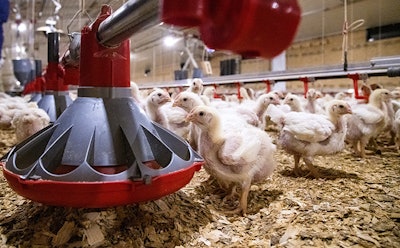
New research at the Tyson Foods’ Broiler Welfare Research Farm (BWRF) leverages animal preference to choose the best environmental enrichments for broiler chickens.
“Caring about the animals that are entrusted to our care at Tyson Foods is pretty inherent to who we are as a company. Our approach to that is grounded in sound science and the latest animal welfare research,” Karen Christensen, senior director animal welfare, Tyson Foods, said.
“We use preference as a key aspect of our research strategy. What I mean by that is that any topic we focus on, we want to present different options to the birds and let them tell us what they want.”
Benefits of enrichment
Enrichments promote natural behaviors and are a key component of any animal welfare program.
It’s important that any project results be ready for use in commercial facilities, so the farm made sure to only test recycled materials that were durable, portable, safe for growers and completely biosecure to prevent the introduction of any possible pathogens.
How preference is measured
Researchers from the University of Arkansas monitored and evaluated chicken behavior with or without enrichments.
Preference was measured through a combination of analysis of psychological factors, such as dopamine and serotonin levels, as well as the assessment of several key health indicators, such as looking at brain activity to determine stress levels.
Ramps, huts or boxes?
The project focused on three types of enrichments: ramps, huts and boxes. So far, huts seem to be the clear winner.
“We’ve found, and the birds have clearly showed us, is that they like an enrichment that lets them get under something or next to something,” Christensen said.
The huts allow the birds to express their natural behaviors, “where they can gather feed quickly where they can see it and then retreat to places that may be safer,” she added.
Next, the researchers plan to compare barns with the hut enrichment to standard control barns, with the expectation of seeing improved behavioral assessments, leg health and dopamine and serotonin regulation in the enriched environments.
The enrichment project is funded by a two-year grant from the U.S. Poultry and Egg Association (USPOULTRY) given to the University of Arkansas, who is collaborating with Tyson Foods. Other projects at BWRF include research on lighting and the how technology can be used to monitor bird health and well-being.
Attend the 2021 Chicken Marketing Summit
Christensen will be a member of a panel discussion on animal welfare at the 2021 edition of Chicken Marketing Summit. During the discussion, panelists will discuss how third-party inspections and continuous improvement programs are improving bird welfare outcomes and the research and selective breeding efforts that will continue to drive improvement. They will also discuss how bird welfare, one component of poultry industry sustainability, impacts other sustainability considerations.
The 2021 Chicken Marketing Summit will be held at the Omni Amelia Island Resort in Fernandina Beach, Florida on July 18-20. This year, the conference will shine a light on what consumers will be looking for in the post-pandemic world and how poultry marketers can find success in the marketplace. Registration is now open with early savings available.
For more information and to attend, visit: www.wattglobalmedia.com/chickenmarketingsummit/
Like what you just read? Sign up now for free to receive the Poultry Future Newsletter.


















